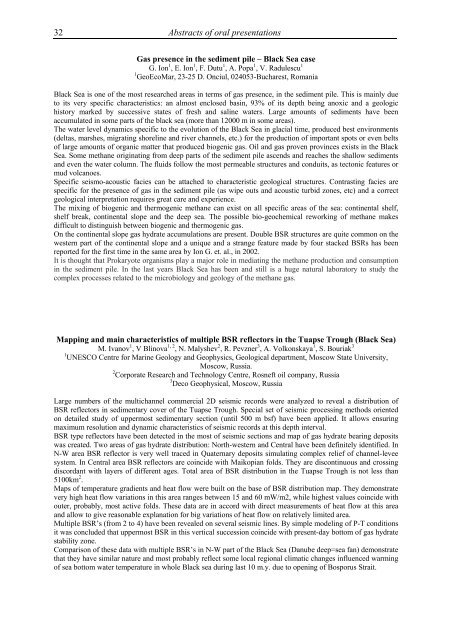Ninth international conference on - Marum
Ninth international conference on - Marum
Ninth international conference on - Marum
Create successful ePaper yourself
Turn your PDF publications into a flip-book with our unique Google optimized e-Paper software.
32<br />
Abstracts of oral presentati<strong>on</strong>s<br />
Gas presence in the sediment pile – Black Sea case<br />
G. I<strong>on</strong> 1 , E. I<strong>on</strong> 1 , F. Dutu 1 , A. Popa 1 , V. Radulescu 1<br />
1 GeoEcoMar, 23-25 D. Onciul, 024053-Bucharest, Romania<br />
Black Sea is <strong>on</strong>e of the most researched areas in terms of gas presence, in the sediment pile. This is mainly due<br />
to its very specific characteristics: an almost enclosed basin, 93% of its depth being anoxic and a geologic<br />
history marked by successive states of fresh and saline waters. Large amounts of sediments have been<br />
accumulated in some parts of the black sea (more than 12000 m in some areas).<br />
The water level dynamics specific to the evoluti<strong>on</strong> of the Black Sea in glacial time, produced best envir<strong>on</strong>ments<br />
(deltas, marshes, migrating shoreline and river channels, etc.) for the producti<strong>on</strong> of important spots or even belts<br />
of large amounts of organic matter that produced biogenic gas. Oil and gas proven provinces exists in the Black<br />
Sea. Some methane originating from deep parts of the sediment pile ascends and reaches the shallow sediments<br />
and even the water column. The fluids follow the most permeable structures and c<strong>on</strong>duits, as tect<strong>on</strong>ic features or<br />
mud volcanoes.<br />
Specific seismo-acoustic facies can be attached to characteristic geological structures. C<strong>on</strong>trasting facies are<br />
specific for the presence of gas in the sediment pile (as wipe outs and acoustic turbid z<strong>on</strong>es, etc) and a correct<br />
geological interpretati<strong>on</strong> requires great care and experience.<br />
The mixing of biogenic and thermogenic methane can exist <strong>on</strong> all specific areas of the sea: c<strong>on</strong>tinental shelf,<br />
shelf break, c<strong>on</strong>tinental slope and the deep sea. The possible bio-geochemical reworking of methane makes<br />
difficult to distinguish between biogenic and thermogenic gas.<br />
On the c<strong>on</strong>tinental slope gas hydrate accumulati<strong>on</strong>s are present. Double BSR structures are quite comm<strong>on</strong> <strong>on</strong> the<br />
western part of the c<strong>on</strong>tinental slope and a unique and a strange feature made by four stacked BSRs has been<br />
reported for the first time in the same area by I<strong>on</strong> G. et. al., in 2002.<br />
It is thought that Prokaryote organisms play a major role in mediating the methane producti<strong>on</strong> and c<strong>on</strong>sumpti<strong>on</strong><br />
in the sediment pile. In the last years Black Sea has been and still is a huge natural laboratory to study the<br />
complex processes related to the microbiology and geology of the methane gas.<br />
Mapping and main characteristics of multiple BSR reflectors in the Tuapse Trough (Black Sea)<br />
M. Ivanov 1 , V Blinova 1, 2 , N. Malyshev 2 , R. Pevzner 3 , A. Volk<strong>on</strong>skaya 1 , S. Bouriak 3<br />
1 UNESCO Centre for Marine Geology and Geophysics, Geological department, Moscow State University,<br />
Moscow, Russia.<br />
2 Corporate Research and Technology Centre, Rosneft oil company, Russia<br />
3 Deco Geophysical, Moscow, Russia<br />
Large numbers of the multichannel commercial 2D seismic records were analyzed to reveal a distributi<strong>on</strong> of<br />
BSR reflectors in sedimentary cover of the Tuapse Trough. Special set of seismic processing methods oriented<br />
<strong>on</strong> detailed study of uppermost sedimentary secti<strong>on</strong> (until 500 m bsf) have been applied. It allows ensuring<br />
maximum resoluti<strong>on</strong> and dynamic characteristics of seismic records at this depth interval.<br />
BSR type reflectors have been detected in the most of seismic secti<strong>on</strong>s and map of gas hydrate bearing deposits<br />
was created. Two areas of gas hydrate distributi<strong>on</strong>: North-western and Central have been definitely identified. In<br />
N-W area BSR reflector is very well traced in Quaternary deposits simulating complex relief of channel-levee<br />
system. In Central area BSR reflectors are coincide with Maikopian folds. They are disc<strong>on</strong>tinuous and crossing<br />
discordant with layers of different ages. Total area of BSR distributi<strong>on</strong> in the Tuapse Trough is not less than<br />
5100km 2 .<br />
Maps of temperature gradients and heat flow were built <strong>on</strong> the base of BSR distributi<strong>on</strong> map. They dem<strong>on</strong>strate<br />
very high heat flow variati<strong>on</strong>s in this area ranges between 15 and 60 mW/m2, while highest values coincide with<br />
outer, probably, most active folds. These data are in accord with direct measurements of heat flow at this area<br />
and allow to give reas<strong>on</strong>able explanati<strong>on</strong> for big variati<strong>on</strong>s of heat flow <strong>on</strong> relatively limited area.<br />
Multiple BSR’s (from 2 to 4) have been revealed <strong>on</strong> several seismic lines. By simple modeling of P-T c<strong>on</strong>diti<strong>on</strong>s<br />
it was c<strong>on</strong>cluded that uppermost BSR in this vertical successi<strong>on</strong> coincide with present-day bottom of gas hydrate<br />
stability z<strong>on</strong>e.<br />
Comparis<strong>on</strong> of these data with multiple BSR’s in N-W part of the Black Sea (Danube deep=sea fan) dem<strong>on</strong>strate<br />
that they have similar nature and most probably reflect some local regi<strong>on</strong>al climatic changes influenced warming<br />
of sea bottom water temperature in whole Black sea during last 10 m.y. due to opening of Bosporus Strait.














